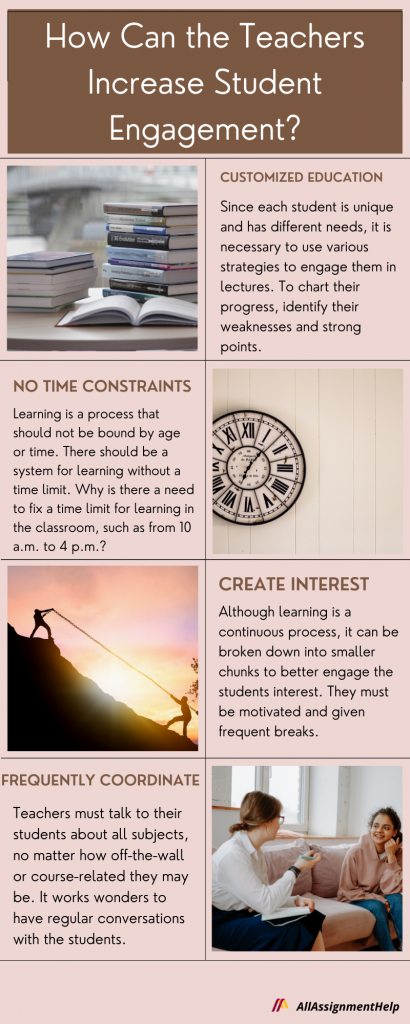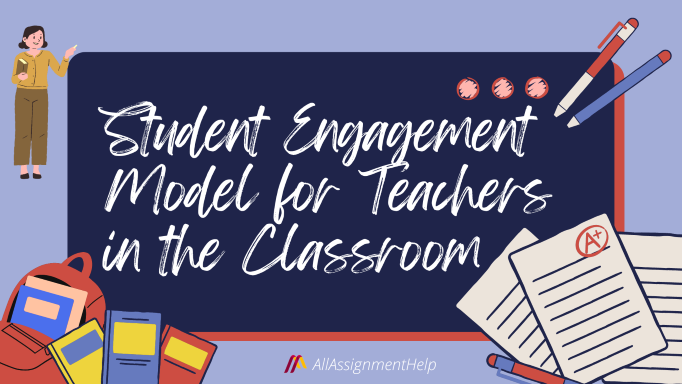Table of Contents
Student engagement is something that we hear every now and then, but unfortunately, we do not understand what it is and how important it is for teachers. Do your students love to attend your classes or lectures? It is a very sensitive question that needs to be asked by all the teachers. According to a survey, fewer than half of the students attend the classes, and even fewer actively participate in the classroom, which is ultimately not a good thing. It is imperative to break this norm and provide the students with a truly valuable learning experience. For this, it is important to fully engage students in the classroom, which will encourage them to participate in their learning process.
To make things simpler and to aid teachers in quickly grasping the student participation model, the experts of AllAssignmentHelp.com has devised this blog. The idea of student learning and the four pillars that focus students’ attention in the classroom will be briefly covered in this blog post.
What Does the Term “Student Engagement” Mean?
According to The Glossary of Education Reform, student engagement “refers to the degree of attention, curiosity, interest, optimism, and passion that students show when they are learning or being taught, which extends to the level of motivation they have to learn and progress in their education.”
If we define student engagement as a single process, it means that it aids in raising students’ performance in the classroom. By bridging the communication gap between instructors and learners, this engagement fosters a positive learning environment. Many terms are contributed in an effort to encourage student participation. The involvement of the students in the lectures is also significantly influenced by the teachers, school administrators, and other individuals. Educational motivation is a crucial aspect of learning because it prevents students from getting bored and keeps them interested for a longer period of time. For young children, this creates a lot of new learning opportunities.
Also Read: How to ace an effective Virtual Classroom Training Session?
Why “Student Engagement” in the Classroom Is Important for the Teachers?
“According to a research study, 25% of students in a classroom of 100% children are only partially attentive, 25% are completely disengaged, 20% make vain attempts to make connections with their classmates and teachers, 25% actively participate in class and comprehend the concepts, and the remaining 5% are already familiar with the subject.”
Based on the aforementioned survey, we can drive to the conclusion that only 25% of all students pay attention to what the teacher is saying, with the remaining 75% being absent-minded in some way. This is why it is crucial for teachers to actively involve their students in their lessons and class. If not the lack of teachers’ engagement may tend to lose intrest in learning. So, how to increase student participation is now the question that must have arrived in everyone’s mind. Well, there are various models of student engagement that will keep the student’s interest during class.
We will go into more detail about each of them as we go forward within this blog article. “To increase student engagement and ownership of learning, we should give students opportunities to do meaningful work – work that makes a difference locally, nationally, and globally.” – Eric Williams
What Kinds of Student Engagement Models Are There?
Successful learning performance is greatly influenced by student engagement. The Campus-Class-Technology (CCT) Theory provides a thorough explanation of this idea. This theory makes it easier to comprehend how students participate in class. Additionally, there are some models for student engagement that the teacher can use to increase the number of active students in the classroom. So let’s just have a concise discussion of the different models.
1- Behavioral Engagement:
This is a tool that identifies the students’ behavioural activities inside the classroom. It means checking what the students are doing in the class, how they are reacting and how they are coordinating with other students. Apart from learning, this also means verifying the social activities and the participation of children in other extra-curricular activities of the school. If the student is not physically active then he or she may not score the highest grades in academics. But never mind if you have valid reason for missing up your class then you can ‘pay someone to do your assignment’ and score good grades.
2- Emotional Engagement:
The student’s emotional performance is the next area to be looked at after the physical activities. It entails monitoring the students’ attitudes and actions both inside and outside of the classroom. Do they seem enthused about the course? How well do they respond to their teachers and fellow students? Being emotionally active is crucial because it will encourage participation in class, which will enhance academic performance.
3- Cognitive Engagement:
This is the most crucial component of the student engagement model. In this section, the student’s interest in their studies is discussed, and it is determined how well they dedicate their time to learning and comprehending the concepts. Do they have motivation, or are the lectures what they’re more interested in? Do they make an effort to comprehend complex ideas? What are their long-term educational objectives? How long do they spend engaged in the lesson? The above mentioned are some of the things which decide the cognitive energy of students.
All of the previously mentioned student engagement strategies can support lecturers in keeping their students interested. Both teachers and students must contribute equally in order to accomplish these goals.
Also Read: Six Effective Tips for Classroom Management
How Can the Teachers Increase Student Engagement?

Student engagement is influenced by several different aspects. The primary individuals who can inspire students to maintain motivation and accomplish their life goals are their teachers. A high level of engagement is essential because it will enhance the students’ learning. Active and engaged learning and by following the below given pillars, students can easily achieve their academic success. The elements that will help the students actively maintain their engagement for a longer period of time are the pillars that are listed below.
1- Customized education:
Since each student is unique and has different needs, it is necessary to use various strategies to engage them in lectures. To chart their progress, identify their weaknesses and strong points. That will produce a tailored learning environment for both you and your students.
2- Learning has no time constraints:
Age or time restrictions shouldn’t apply to the process of learning. There should be a system for learning without a time limit. Why is there a need to fix a time limit for learning in the classroom, such as from 10 a.m. to 4 p.m.? This is a continuous process that should not have any boundaries, at least no time limits.
3- Create interest among students:
Although students should be in charge of their own education and success, teachers still have a duty to pique their interest. The teachers must get them involved in extracurricular activities and help them accomplish their objectives. Although learning is a continuous process, it can be broken down into smaller chunks to better engage the students interest. They must be motivated and given frequent breaks.
4- Competency-Based Learning:
Execution is more crucial because memorising a formula is useless if a student cannot use it to solve a problem. Actually, there is no point! Different stages of education should include outside elements like competition that have an impact on students’ learning. Periodically implementing easy learning activities is necessary to increase students’ involvement.
5- Classroom games:
Another tried-and-true strategy for motivating pupils to study well is to simulate a classroom environment. The games can be related to the coursework or they can also play soft games to develop their knowledge and hone their skills.
6- Frequently coordinate with the childrens:
It works wonders to have regular conversations with the students. This is the area in which many teachers fall short. Teachers must talk to their students about all subjects, no matter how off-the-wall or course-related they may be. These two discussions can broaden their thinking without becoming tedious and repetitive.
These methods of student involvement can be quite engaging and beneficial for students in achieving and raising their test scores. The most effective ways to standardize children’s grades are through these pillars. If not, there are a variety of other ways to achieve academic success. The best one of all is to seek help from professional class takers online. School and college students may pay for online class help. Expert assistance services are expanding quickly and aiding students in raising their educational outcomes.
Conclusion
The above-discussed pillars were specially created by knowledgeable academics to make it suitable for all the class level, and courses for the intended students. Students can improve their study engagement by using a variety of apps and websites. They can also establish a study group in which faculty members can participate by signing up for various forums, social media sites, or communities. They can share resources, post polls, and start conversations with one another there. Students can learn about various learning styles by sharing different kinds of study materials. A specific student may even have access to these study materials for a more individualized learning experience.
Since there is no set time limit for study, all of these can be very engaging for students. They are always free to start a conversation with other students or teachers. As a result, the goal of student engagement will be fulfilled, and without making them bored. They will be motivated to learn, and even the classroom will be a stimulating environment for them to experiment with new ideas. The issue of a teacher can be resolved in a welcoming setting, and perfect attendance will start to be expected in the classroom.
Also Read: How to Develop Strategies for Students to Attend the Classroom?
Frequently Asked Questions
| Question 1: How can the student achieve active learning in the classroom? Answer 1: Active writing, active listening and actively participating and asking questions in the classroom are some of the key reasons which can help the student in learning. |
| Question 2: What are the different student engagement models? Answer 2: The student engagement models which helps the students to actively focus in the class room are behavioral engagement, intellectual engagement, social engagement, cultural engagement, cognitive engagement and emotional engagement. |
| Question 3: What are the various types of learning engagement for the school students? Answer 3: Procedural engagement, Conceptual engagement, Consequential engagement, Critical engagement are the different types which helps the students to improve their learning engagement. These four learning engagements can totally change the learning experience of the learners. |
